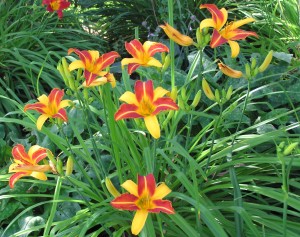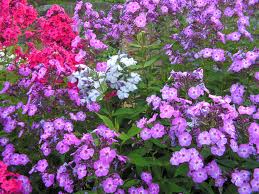In my earlier blog I mentioned lots of lovely garden plants that can be eaten to make a really beautiful and edible garden.
Deliberately I left out a few that can be eaten but could in some way cause problems, but now I’m adding what I know about these plants in case I’m accused of ‘nannying’!
These ‘be careful’ plants come in all shapes, colours – and flavours.
Agastache anisata/foeniculum – I think these are really lovely ‘all rounders’. They not only look lovely, and have a beautiful delicate scent of aniseed, but bees, butterflies and lots of birds really, really love them.
Both flowers and leaves can be added to cakes, desserts, and yoghurts for a subtle flavour and fragrance of anise.
It really is best avoided though if you are pregnant ( its a real shame that pregnant ladies have to miss out on stuff so often !)
Begonia – but only the tuberhybrida, and only the petals. Delicate lemony taste, and the crispy texture is nice, but as they have a high content of oxalic acid so don’t make a pig of yourself ! (And if you have a tendency to gout, kidney stones or rheumatism then avoid altogether.)
Borage – Another lovely flower I think (although I am partial to blue flowers.) Mix the flowers into salads, fruit salads or drinks to add a cucumber taste, plus they really add to the look of any dish.
Again though, best avoided by pregnant ladies and mums who are lactating . They can also have a diuretic effect, so would suggest no more than 7 or 8 flowers at a ‘sitting’ !
Catmint – Nepeta cataria is another of my favourites (blue again you see) and its flowers have quite a strong flavour combining mintiness ( surprise) and spiciness.
Goes beautifully with lamb and can pep up vegetables and pasta dishes, but for pregnant women though, the ‘Nepeta’ is definitely best avoided.
Daisy – You can play ‘Love Me – Love Me not’ as you pull the flowers apart to make a lovely petal garnish to all sorts of dishes from soups to salads. Not much flavour, although some people think they are bitter, and be careful if you a subject to allergies or hay fever.
They can trigger both.
Daylily – Admit I do not grow these, they really are so short lived (‘Day Lily’ the clue is in the name !)
However, they really are versatile, almost like a vegetable. The early foliage (tasting a little like delicate onion when fried) later flowers and buds (raw or cooked adding sweetness) and even the rhizomes (nutty flavour) are edible – all are often found in Chinese cooking. What’s to be cautious about then ?
Well nothing so long as you only consume Daylillies Hemerocallis , just hate anybody to think that all lillies (Lillium)are edible – they’re not, they are poisonous !
Garland Chrysanthemum – coronnarium. There is nothing to be cautious about here either really. The strongly spiced flowers add pep to salads, and ‘Japanese Chrysanthemum’ soup can be a real signature dish. But I just feel the same as I do about the Daylilly and Lillies in general, only ‘coronarium’ is safe – avoid all other Chrysanthemums.
Phlox – paniculata. Really beautiful fragrant flowers, with a spicy flavour that adds real pizzaz to fruit salads. (Some people crystallize them as they look so lovely decorating cakes and pastries.) Nope nothing wrong at all with the perrenial paniculata, but do not confuse it with the annual creeping phlox (Phlox subulata) this is NOT edible, and this is the only reason it’s on my ‘caution’ list.
Poppy – Papaver somniferum and paeoniflorum. Well all poppies are poisonous, and it is only the seeds from these two species that are edible, nothing else. I do love them though baked into, or sprinkled on the top, of bread (they always go everywhere when I’m cutting a slice though !)
Unless you know exactly which poppies are safe though, think they are best left in the garden.
Think every garden should have these cheerful plants though, do you know of any flower which is so poignant, evocative and beautiful ?
Hope this blog gives a few more ideas for your ‘Edible Garden’.
Treat cautiously and all of the above plants will really add to your environment, and your kitchen !











I was wondering if you would list your sources for the phlox, poppies and other types of daylilies as being poisonous.. are any of them primary sources, or are you just quoting some other site that also doesn’t have a source? I have also found sources of people who claim they are edible and have eaten them.
what is the compound that makes them toxic?
Hi,
Most of detail is extracted from RHS, Wikipedia and various horticultural studies.
To answer your queries separately :-
Lillies
The most common English names are flame lily, fire lily, gloriosa lily, glory lily, superb lily, climbing lily, and creeping lily.
All parts of the plant contain colchicine and related alkaloids and are therefore dangerously toxic if ingested, and contact with the stems and leaves can cause skin irritation.
Lily of the valley (although not a true ‘Lilly’ is a sweetly scented, highly poisonous woodland flowering plan containing cardiac glycosides.
(Some Lilium species are toxic to cats. This is known to be so especially for Lilium longiflorum though other Lilium and the unrelated Hemerocallis can also cause the same symptoms. The true mechanism of toxicity is undetermined, but it involves damage to the renal tubular epithelium – composing the substance of the kidney and secreting, collecting, and conducting urine – which can cause acute renal failure. )
Chinese cuisine and medicine does use lillies (bulbs mainly)
野百合Lilium brownii, 百合(变种) Lilium brownii var. viridulum, 渥丹 Lilium concolor, 毛百合 Lilium dauricum, 川百合 Lilium davidii, 东北百合 Lilium distichum, 卷丹 Lilium lancifolium, 新疆百合(变种) Lilium martagon var. pilosiusculum, 山丹 Lilium pumilum, 南川百合Lilium rosthornii, 药百合(变种)Lilium speciosum var. gloriosoides.
Herb use:[47][48]
野百合 Lilium brownii, 百合(变种) Lilium brownii var. viridulum, 渥丹 Lilium concolor, 毛百合 Lilium dauricum, 卷丹 Lilium lancifolium, 山丹 Lilium pumilum, 南川百合 Lilium rosthornii, 药百合(变种)Lilium speciosum var. gloriosoides]], 淡黄花百合 Lilium sulphureum.
However, I personally would avoid totally unless I was highly skilled at what I was preparing.
Phlox subulata
It is only this evergreen ground cover version of Phlox that is inedible. To my knowledge it is not toxic, but not digestible.
Poppies (Papaveraceae family)
Nearly all of this plant family, and all of the plant, contains alkaloids the most common of which is codeine/morphine/opium. The ESA recently released a further paper on toxicity http://www.efsa.europa.eu/sites/default/files/scientific_output/files/main_documents/2405.pdf
Only the mature dry seeds of the poppies Papaver somniferum and paeoniflorum are safe to eat.
Do hope this reply answers your questions.
Kind regards
Louise